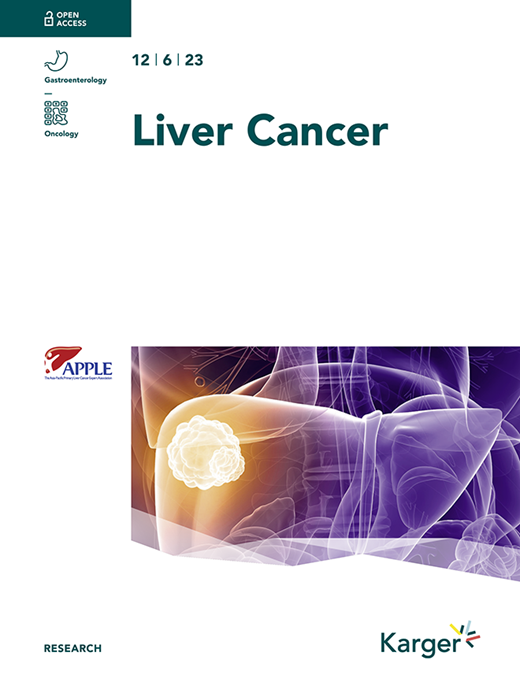Survival Outcome Analysis of Stereotactic Body Radiotherapy and Immunotherapy (SBRT-IO) versus SBRT-alone in Unresectable Hepatocellular Carcinoma (HCC)
IF 9.1
1区 医学
Q1 GASTROENTEROLOGY & HEPATOLOGY
引用次数: 0
Abstract
Introduction: While combination of stereotactic body radiotherapy (SBRT) and immunotherapy are promising, their efficacy and safety have not been compared with SBRT-alone in patients with unresectable hepatocellular carcinoma (HCC). Methods: This retrospective study included 100 patients with nonmetastatic, unresectable HCC in two hospitals. Eligible patients had tumor nodules ≤3 and Child-Pugh liver function score of A5 to B7. Seventy patients received SBRT-alone, and 30 patients underwent combined SBRT and immunotherapy (SBRT-IO). Overall survival (OS), time to progression (TTP), overall response rate (ORR), and toxicity were analyzed. We adjusted for the potential confounding factors using propensity score matching. Results: The median tumor size was 7.3 cm (range, 2.6–18 cm). Twenty-five (25%) of patients had vascular invasion. Before propensity score matching, the 1-year and 3-year OS rate was 89.9% and 59.8% in the SBRT-IO group and 75.7% and 42.3% in SBRT-alone group (p = 0.039). After propensity score matching (1:2), 25 and 50 patients were selected from the SBRT-IO and SBRT-alone group. The 1-year and 3-year OS was 92.0% and 63.9% in the SBRT-IO group versus 74.0% and 43.3% in the SBRT-alone group (p = 0.034). The 1-year and 3-year TTP was better in SBRT-IO group (1-year: 68.9% vs. 58.9% and 3-year: 61.3% vs. 32.5%, p = 0.057). The ORR of 88% (complete response [CR]: 56%, partial response [PR]: 22%) in SBRT-IO arm was significantly better than 50% (CR: 20%, PR: 30%) in the SBRT-alone arm (p = 0.006). Three patients (12%) developed ≥grade 3 immune-related treatment adverse events (n = 2 hepatitis, n = 1 dermatitis) leading to permanent treatment discontinuation. Conclusion: Adding immunotherapy to SBRT resulted in better survival with manageable toxicities. Prospective randomized trial is warranted.立体定向放疗和免疫治疗(SBRT-IO)与单用sbrt治疗不可切除肝细胞癌的生存结局分析
& lt; b> & lt; i>简介:& lt; / i> & lt; / b>虽然立体定向体放疗(SBRT)和免疫治疗联合应用很有前景,但在不可切除的肝细胞癌(HCC)患者中,其疗效和安全性尚未与单独使用SBRT进行比较。& lt; b> & lt; i>方法:& lt; / i> & lt; / b>本回顾性研究包括两家医院的100例非转移性、不可切除的HCC患者。符合条件的患者肿瘤结节≤3,Child-Pugh肝功能评分为A5 ~ B7。70例患者单独接受SBRT治疗,30例患者接受SBRT联合免疫治疗(SBRT- io)。分析总生存期(OS)、进展时间(TTP)、总缓解率(ORR)和毒性。我们使用倾向评分匹配来调整潜在的混杂因素。& lt; b> & lt; i>结果:& lt; / i> & lt; / b>中位肿瘤大小7.3 cm(范围2.6 ~ 18 cm)。25例(25%)患者有血管侵犯。倾向评分匹配前,SBRT-IO组1年和3年的OS率分别为89.9%和59.8%,单独sbrt组为75.7%和42.3% (<i>p</i>= 0.039)。经倾向评分匹配(1:2)后,分别从SBRT-IO组和单独sbrt组中选择25例和50例患者。SBRT-IO组1年和3年的OS分别为92.0%和63.9%,而单独sbrt组为74.0%和43.3% (<i>p</i>= 0.034)。SBRT-IO组1年和3年TTP较好(1年:68.9% vs. 58.9%, 3年:61.3% vs. 32.5%, <i>p</i>= 0.057)。SBRT-IO组的ORR为88%(完全缓解[CR]: 56%,部分缓解[PR]: 22%),显著优于单独sbrt组的50% (CR: 20%, PR: 30%) (<i>p</i>= 0.006)。3例患者(12%)发生≥3级免疫相关治疗不良事件(<i>n</i>= 2肝炎,<i>n</i>= 1例皮炎)导致永久停止治疗。& lt; b> & lt; i>结论:& lt; / i> & lt; / b>在SBRT中加入免疫疗法可提高生存率,毒性可控。前瞻性随机试验是必要的。
本文章由计算机程序翻译,如有差异,请以英文原文为准。
求助全文
约1分钟内获得全文
求助全文
来源期刊

Liver Cancer
Medicine-Oncology
CiteScore
20.80
自引率
7.20%
发文量
53
审稿时长
16 weeks
期刊介绍:
Liver Cancer is a journal that serves the international community of researchers and clinicians by providing a platform for research results related to the causes, mechanisms, and therapy of liver cancer. It focuses on molecular carcinogenesis, prevention, surveillance, diagnosis, and treatment, including molecular targeted therapy. The journal publishes clinical and translational research in the field of liver cancer in both humans and experimental models. It publishes original and review articles and has an Impact Factor of 13.8. The journal is indexed and abstracted in various platforms including PubMed, PubMed Central, Web of Science, Science Citation Index, Science Citation Index Expanded, Google Scholar, DOAJ, Chemical Abstracts Service, Scopus, Embase, Pathway Studio, and WorldCat.
 求助内容:
求助内容: 应助结果提醒方式:
应助结果提醒方式:


